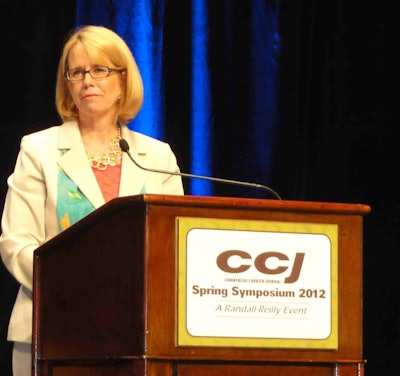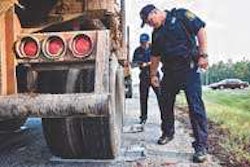
Updating CCJ Spring Symposium attendees on the latest Federal Motor Carrier Safety Administration rulemakings, FMCSA Administrator Anne Ferro on Tuesday, May 22, said the industry can be on the lookout for a Safety Fitness Determination proposal and perhaps a rulemaking in 2013, as well as possibly a long-awaited entry-level driver training rule.
The Safety Measurement System – which Ferro described as one of “the three core components” of FMCSA’s Compliance, Safety, Accountability program – replaced SafeStat to determine which fleets should be eyeballed for roadside inspections and to provide fleets with better visibility. Under the Safety Fitness Determination, FMCSA could use that data to replace the onsite inspection process.
Ferro said feedback regarding the CSA preview now available to fleets is critical. “That preview is under way because we want your input,” she told Symposium attendees. “Some in the industry are very concerned, and we need to know what those concerns are so that we can address them.”
Ferro estimated a current population of about 500,000 freight carriers and said that about 490,000 of those have no fatality numbers. “We have 200,000 carriers with sufficient data to analyze for all carriers, and 92 percent of all crashes are attributed to those carriers,” she said. “They represent 80 percent of the power units. Crash history is one of the stronger predictors of future crashes. How are we going to address crash accountability when it comes to addressing the (Behavior Analysis Safety Improvement Categories)?”
Ferro said the agency calls this process “crash weighting” – preventable vs. nonpreventable. “We started to answer that question through police reports, but those vary from state to state,” she said. “Over the course of the 90-day filing period, the content may change. So our challenge is if we have the final final report?”
Another element of CSA is how to make it a fair and open system, Ferro said. “If a company has a comment, how do we address that and other parties in the report, and if that process improves safety?” she said.
To make the system more fair for flatbed carriers, FMCSA recently moved Load Securement from the Cargo-Related BASIC to Vehicle Maintenance. “There was some concern that we were diluting the Load Securement category, but our accuracy went up 40 percent,” Ferro said.
Ferro also discussed where the electronic onboard recorder rulemaking process now stands in light of the Owner-Operator Independent Drivers Association’s successful court challenge that FMCSA failed to address how fleets would be prevented from using the devices to harass drivers.
“We’ve worked closely with EOBR partners – vendors, carriers and law enforcement – on the technical standards,” she said. “We’ve also worked with drivers to learn more about the harassment issue.” FMCSA also must address the issue of hours-of-service supporting documents for EOBRs , she said.
All of those components will be addressed in a forthcoming Supplemental Notice of Proposed Rulemaking on EOBRs, due late this year or early 2013. “It will be a proposal, and we’ll need your feedback,” Ferro said.
Ferro also reminded Symposium attendees of the July 2013 effective date of FMCSA’s final hours-of-service rule, but chose not to address pending legal action targeting the rule and instead emphasized its definitive status in the agency’s eyes. “The whole intent was to target cumulative fatigue,” she said of the new 34-hour restart provision.
Regarding FMCSA’s recent final rules forbidding texting and use of handhelds while driving a commercial vehicle, Ferro said “It’s remarkable that 1,300 drivers and 1,000 companies have been cited since the rule went in effect.”
Discussing the recent final rule for a National Registry of Certified Medical Examiners, Ferro said medical examiners can begin enrolling this summer and that the curriculum already is online. She encouraged fleets to recommend that their preferred physicians enroll before the mandate takes effect in May 2014.
An entry-level driver training rule probably won’t be forthcoming until 2013, said Ferro, attributing the delay to problems tying improved safety to training. “It has been tough to document the long-term benefits to safety,” she said. “It defies common sense – we all know a trained driver is better.” Government agencies have to conduct a cost-benefit analysis even when a rule seems obviously beneficial, but this has proven difficult with the training rulemaking, she said.
FMCSA also is researching the effect of shipper detention time on driver safety, Ferro said. “It’s a serious impact in our view on some drivers’ ability to operate safety,” she said. “While we have no authority over shippers, we meet with them to explain the SMS and how that affects their carrier relationships.”
The agency’s newly finalized Five-Year Strategic Plan addresses how every entity in the supply chain needs to be responsible for their actions that affect safety, Ferro said. “What shippers do matters to safety, and they need to be held accountable for that.”












